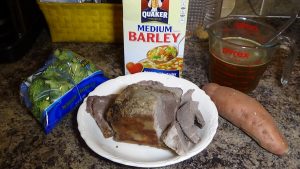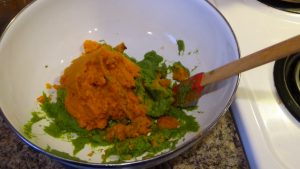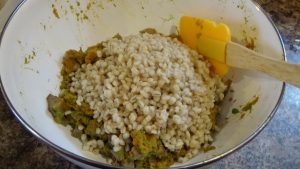I’ve been working on a book for some time now. It’s called Cooking for Your Dog, not exactly an inspired title, and that will probably change before it goes to print. Marie will come up with something catchier.
 The book is, as the mundane title says, about cooking food for your dog. But it’s not just recipes. It’s chock full of information on canine nutrition and the various ways they differ from people in what they can and cannot eat and why. I’ve been researching it for a long time because it takes a lot of effort to validate information that is found on the internet. In case you haven’t discovered it yet, you can’t trust everything on the internet to be accurate or even true. Such is the case here. Companies that make kibble sponsor “studies” that slam canned food. Canned food producers disseminate info, through side channels, that tells how dangerous raw diet is and how much healthier a canned diet is. You get the idea: everyone has an agenda and you can’t always tell who sponsored a particular study, or if it was truly unbiased. I asked Dr. Sandra Conard Manes DVM for help in sifting through the hype and getting at the “meat” of this issue.
The book is, as the mundane title says, about cooking food for your dog. But it’s not just recipes. It’s chock full of information on canine nutrition and the various ways they differ from people in what they can and cannot eat and why. I’ve been researching it for a long time because it takes a lot of effort to validate information that is found on the internet. In case you haven’t discovered it yet, you can’t trust everything on the internet to be accurate or even true. Such is the case here. Companies that make kibble sponsor “studies” that slam canned food. Canned food producers disseminate info, through side channels, that tells how dangerous raw diet is and how much healthier a canned diet is. You get the idea: everyone has an agenda and you can’t always tell who sponsored a particular study, or if it was truly unbiased. I asked Dr. Sandra Conard Manes DVM for help in sifting through the hype and getting at the “meat” of this issue.
I’ve got a few details to finish up, but it’s mostly written. I just need to test the recipes.
Getting Phoenix to eat enough to gain the weight she needs to gain has been a challenge since she does not like kibble, and gets bored with canned food. Besides, good quality canned dog food is expensive. I came to the realization that if I’m going to be spending over $40.00 per week on canned food for one dog, I could be testing the recipes and probably saving some money as well.
So here is documentation of my first recipe test and what I learned as I went.
Broccoli-Beef Doggie Stew
Ingredients
 2 cups Beef cut into 1/4″ cubes. We used a roast, but you can use whatever cut you want.
2 cups Beef cut into 1/4″ cubes. We used a roast, but you can use whatever cut you want.- 1½ cups of chopped broccoli
- 1 large sweet potato (needs to yield 2 cups when mashed)
- ½ cup barley
- 4 cups liquid (including beef broth)
- 1000 mg calcium citrate
 Steam the veggies until soft. Don’t boil them. Then mash or puree to release the nutrients, a dog’s gut does not break down cellulose like ours do, so they can’t get at the nutrients of many plants, especially leafy plants. Use some of the beef broth for thinning the puree so it renders down smoothly.
Steam the veggies until soft. Don’t boil them. Then mash or puree to release the nutrients, a dog’s gut does not break down cellulose like ours do, so they can’t get at the nutrients of many plants, especially leafy plants. Use some of the beef broth for thinning the puree so it renders down smoothly.
 Cube up your beef. Cut it into small pieces that won’t choke your dog (they are not known for diligently chewing their food) and will be easily digested. Trim away excess fat. Too much meat fat causes pancreatitis in dogs.
Cube up your beef. Cut it into small pieces that won’t choke your dog (they are not known for diligently chewing their food) and will be easily digested. Trim away excess fat. Too much meat fat causes pancreatitis in dogs.
 Boil up the barley according to package directions. You may have to do some math here — or just make a larger amount and save the excess in the fridge for the next batch. Use the beef broth to cook the barley. If you need to drain off excess liquid after cooking, use a strainer and bowl to capture the liquid, don’t pour it down the drain. That has good stuff in it, don’t waste it.
Boil up the barley according to package directions. You may have to do some math here — or just make a larger amount and save the excess in the fridge for the next batch. Use the beef broth to cook the barley. If you need to drain off excess liquid after cooking, use a strainer and bowl to capture the liquid, don’t pour it down the drain. That has good stuff in it, don’t waste it.
Add the calcium citrate. You can use vitamin C capsules for this. If they are the gel-caps, pull them apart and add the powder. If a tablet, crush it/them in a pull crusher or between two large, nested spoons. Calcium is important to your dog’s diet. A wild dog gets calcium by eating the bones of its prey. If you have a great butcher shop near by, you can get beef ground with bones in, just for dogs. If not, add calcium citrate or dietary bone meal to the recipes. Do not use the bone meal you find in the store’s gardening section.
The result is going to be stiff. Add beef broth – barley water to thin to a pleasing consistency. Go ahead and give it a taste, everything you’ve used is human grade food so just because you’re calling it dog food doesn’t mean you can’t try a bit. I can definitely taste the sweet potato, the broccoli is more subtle. That’s a good thing as far as dogs go.
Okay, pack that into an air-tight container and store it in the fridge. If you have any liquid left, save that too, you’ll need it for thinning in days to come: it will stiffen up as it sits.
How Much To Feed?
This was the hardest question to find a good answer for, and I’m going to give it to you for free! But first, some preamble.
If you are accustomed to feeding your dog canned food, you are probably thinking that the slightly over 3 pounds of stew this recipe produces won’t last but a day. Less if you have a large dog. Because you’re used to feeding your dog 3 to 8 cans of food per day. That’s because commercial dog food is notoriously low on nutrient and high on fillers. The cheaper the brand, the more true this is. The top brands (see www.DogFoodAdvisor.com) contain less bulk, but cost $2.00 to $3.00 per can.
My book goes into how to arrange for a balanced diet. This one recipe will not do it. You’ll need to vary ingredients to achieve nutritional balance over the long haul. A general rule of thumb to use with any of the recipes in my book is to figure 2% to 3% of your dog’s ideal body weight in home-made food per day. Note that I said “ideal body weight” and “per DAY” not per meal.
Let’s do a couple of examples.
This stew, as I made it, weighs 10 ounces per cup. Let’s write that on a sticky-note and pop it right up here where we can see it while we work this stuff out.
Phoenix

Phoenix needs to weigh 55 pounds. She is well under that right now, but that’s what we’re working toward so that’s what we use as a feeding basis. And since we want her to gain weight, I’ll use the 3% figure. 3% of 55 pounds is 1.65 pounds or 26.4 ounces, of food per day. She gets fed 3 times a day, so we divide that into thirds, and she needs just under 9 ounces. (check the sticky note) Not quite a cup of stew per feeding.
As she closes in on her ideal weight we can cut back to the 2% figure or 5.9 ounces (call it 6 oz) of stew per feeding (check the sticky note) or about 2/3 cup.
Blondie Bear
 Blondie Bear should weigh 80 pounds. She usually runs heavier, so we’ll use the 2% figure.
Blondie Bear should weigh 80 pounds. She usually runs heavier, so we’ll use the 2% figure.
2% of 80 pounds is 1.6 pounds. Let’s convert that to ounces now: 1.6 x 16 = 25.6 ounces needed per day.
25.6 divided into two meals per day is 12.8 oz. per meal. Let’s call it 13. (check the sticky note) That’s 1 1/3 cups per meal.
That’s equivalent to what she gets fed in kibble. The canned food we’ve been using says to feed one can per 15 pounds per day. That’s 2 3/4 cans per meal. That’s a lot of food!
Dr. Manes agrees with other evaluators who say that even the best dog kibble is essentially junk food. It has to be cooked at such high temperatures to produce shelf-stable dry nuggets that most of the nutrient contend is killed off in the process. A top brand of kibble is better than a cheap brand of kibble, but kibble is still kibble.
If I really want to do this right, I should just start making my own dog food for the whole pack. I’d only need 8 pounds of home made food per day — that’s three times the batch I made today.
Every day. (sigh)



